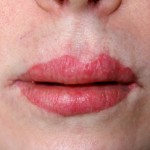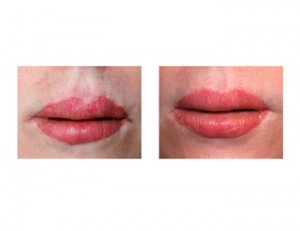Background: While injectable fillers are the most common form of lip augmentation, there are limits as to the lip changes they can achieve. While fillers add volume, they have a limited ability to significantly increase the vertical height of the lip. The vertical or visible size of the lip vermilion is what all forms of lip augmentation are designed to achieve. If too much injectable filler or if the vertical height of the lip vermilion is small, the lip will be pushed out horizontally but not enough vertically. This creates the classic injectable filler deformity known as ‘duck lips’.
If the lip is very thin (small amount of vertical vermilion height), a surgical approach rather than an injectable filler will produce a better result. One of the surgical lip augmentation choices is a vermilion or lip advancement. By removing a strip of skin above the whole length of the lip, the vermilion edge can be up (for the upper lip) or down. (for the lower lip) By moving the edge of the vermilion, a powerful change in the size of the lip can be seen.
Lip advancements are relatively straightforward office procedures done under local anesthesia. On the surface, they seem simple and uncomplicated…and they are. But they require create precision in their execution to have an even lip edge from one mouth corner to the other and a meticulous design and alignment of the cupid’s bow of the upper lip. Being off fractions of a millimeter can easily result in obvious lip distortions and an unnatural look. Poor suturing or suture reactions at the vermilion-cutaneous border can result in visible scar.



Case Highlights:
1) Lip advancements require great precision in their execution or lip distortions, asymmetries and visible scarring can result.
2) Revisions of lip advancement complications can be done through cupid’s bow realignment, vermilion line adjustments and hypertrophic scar excisions.
3) Lip advancement revisions, like the original procedure, can be done under local anesthesia in an office setting.
Dr. Barry Eppley
Indianapolis, Indiana


